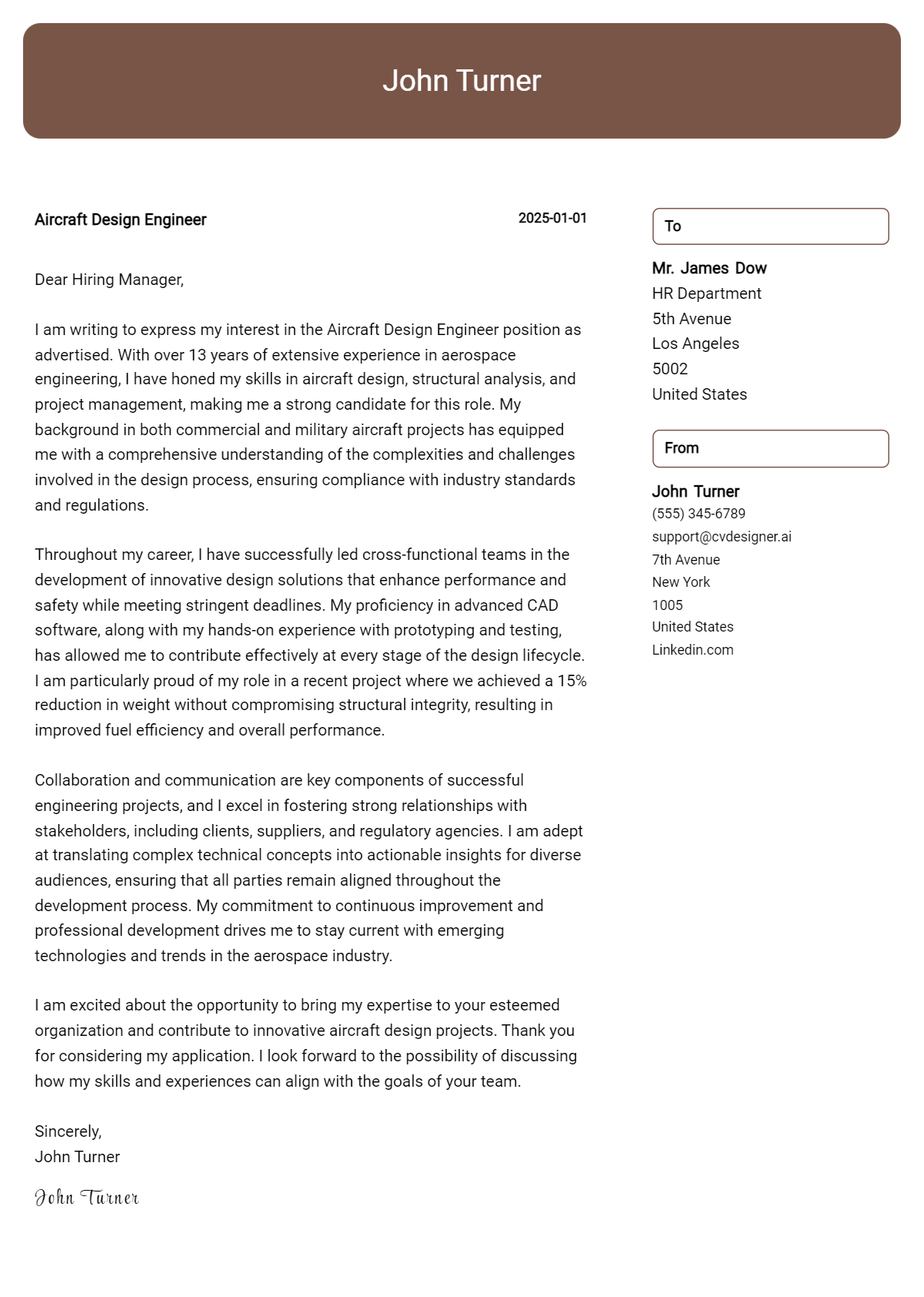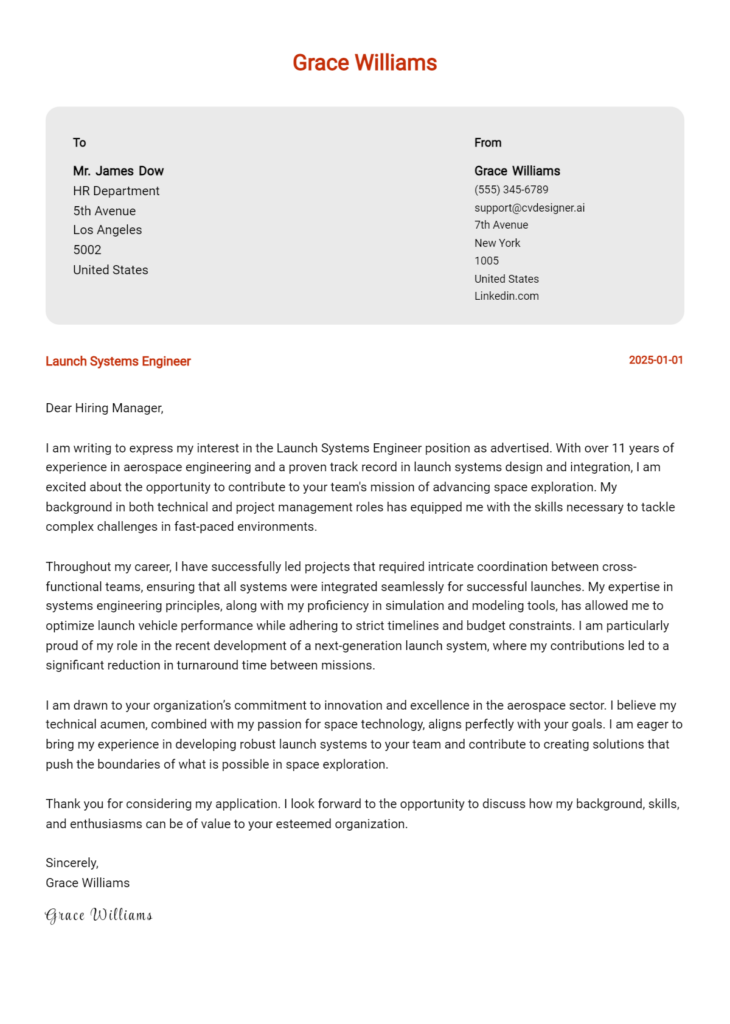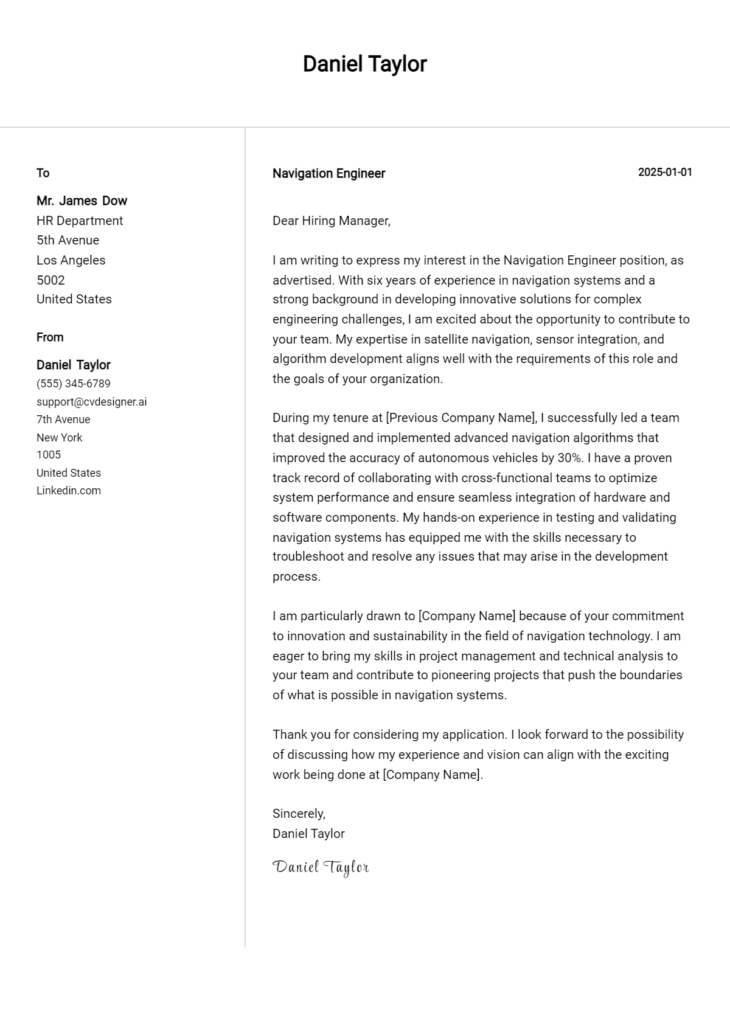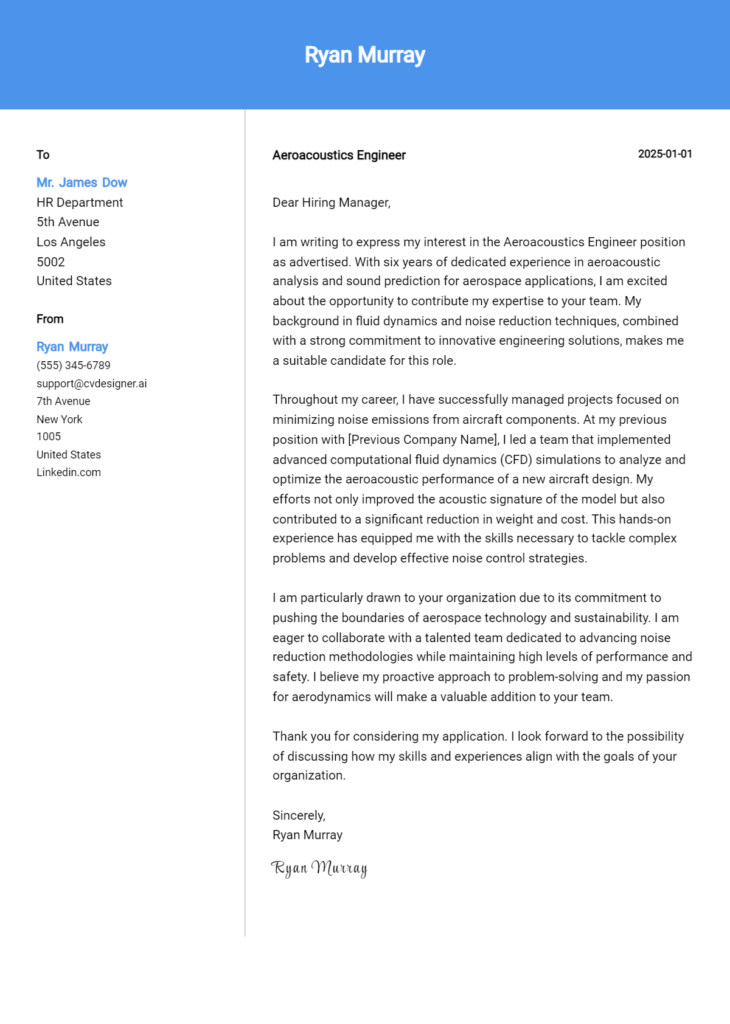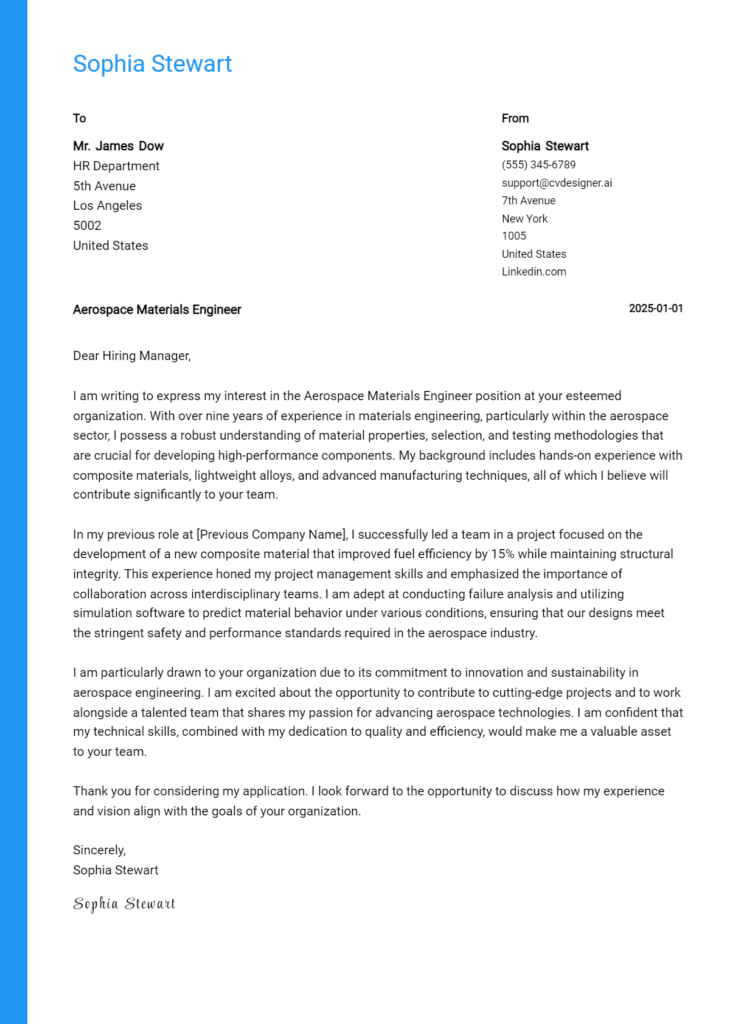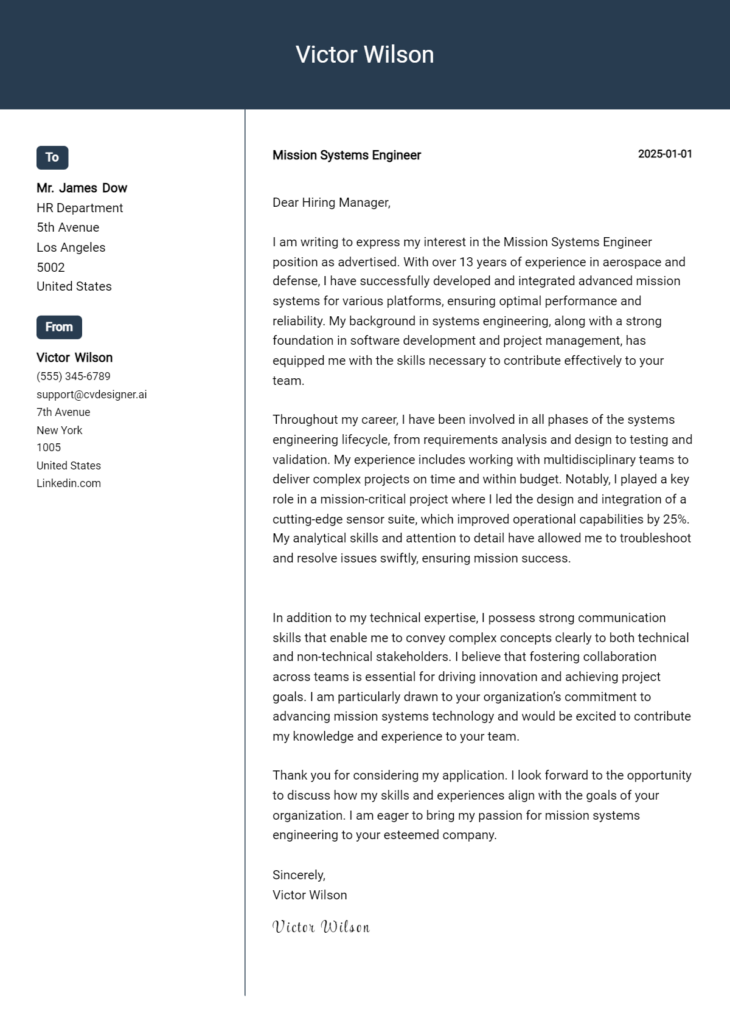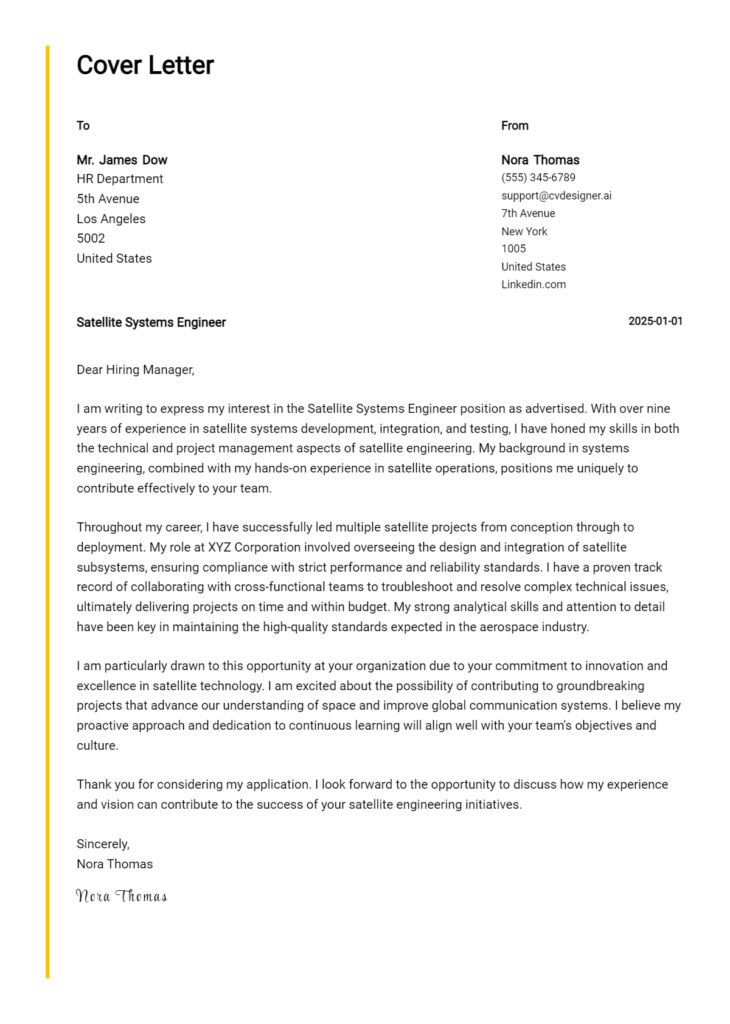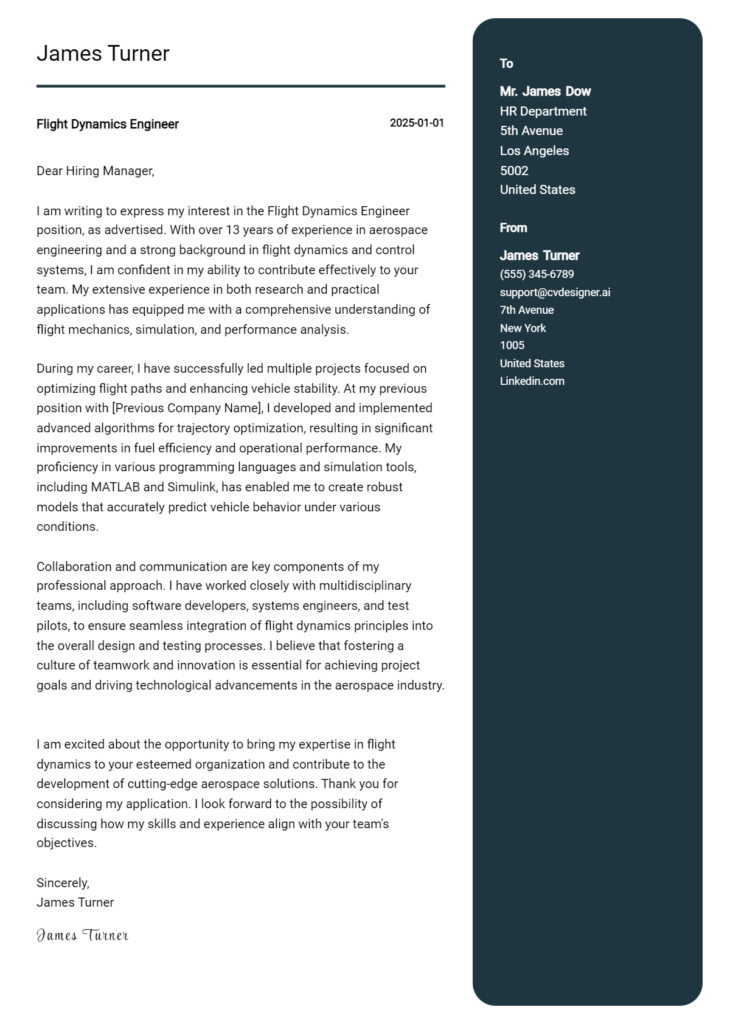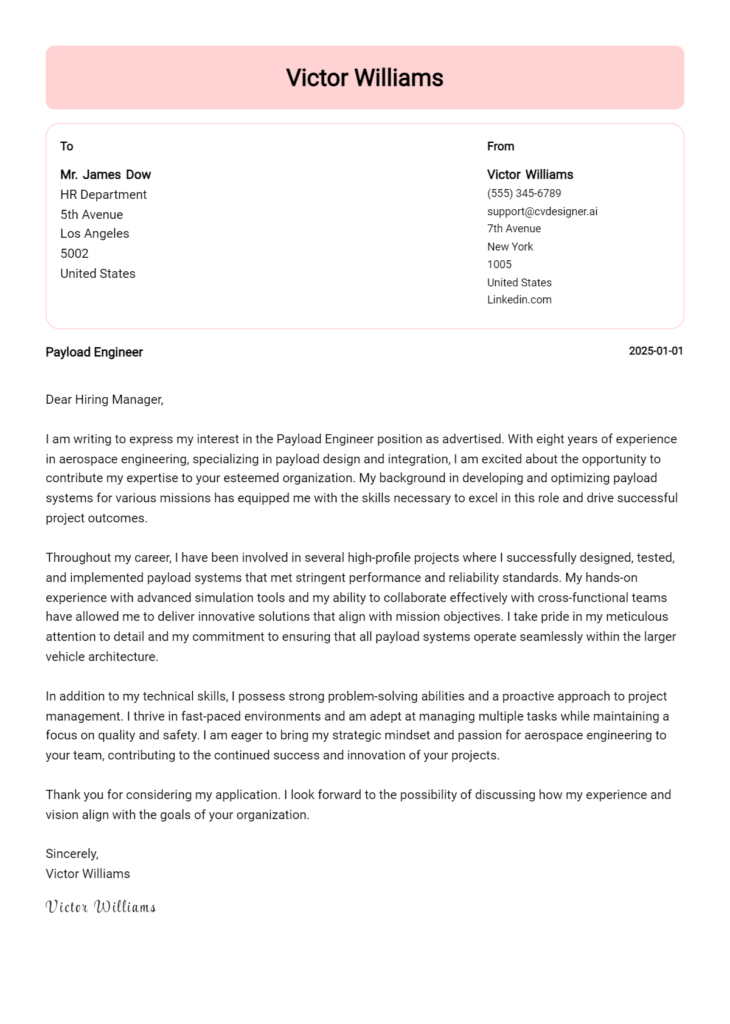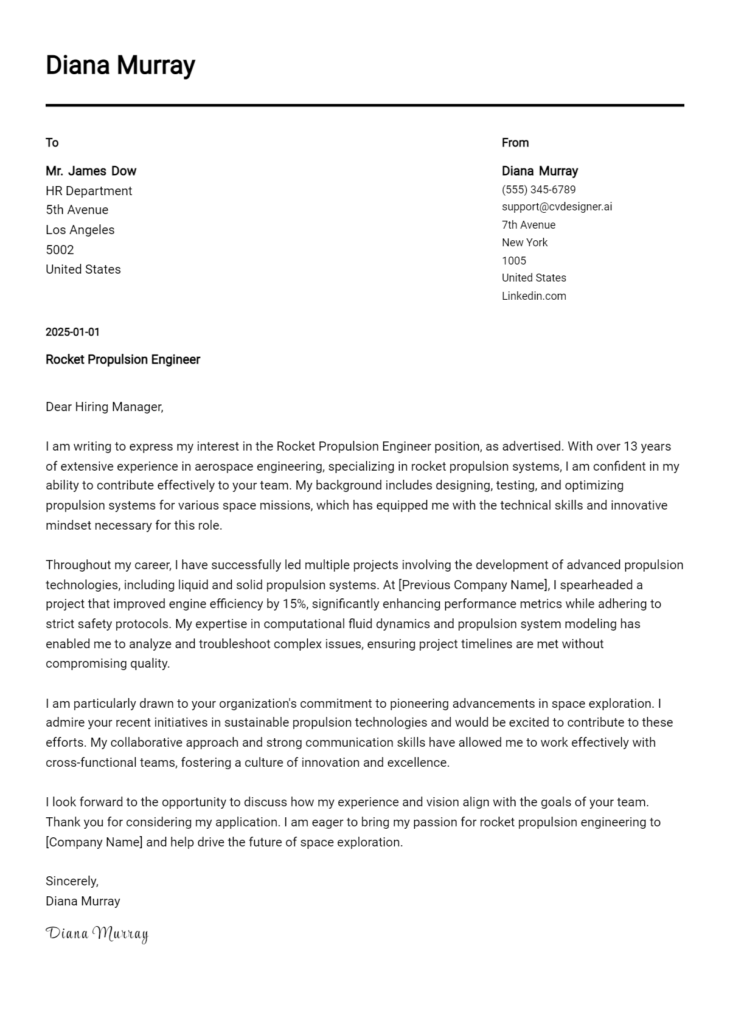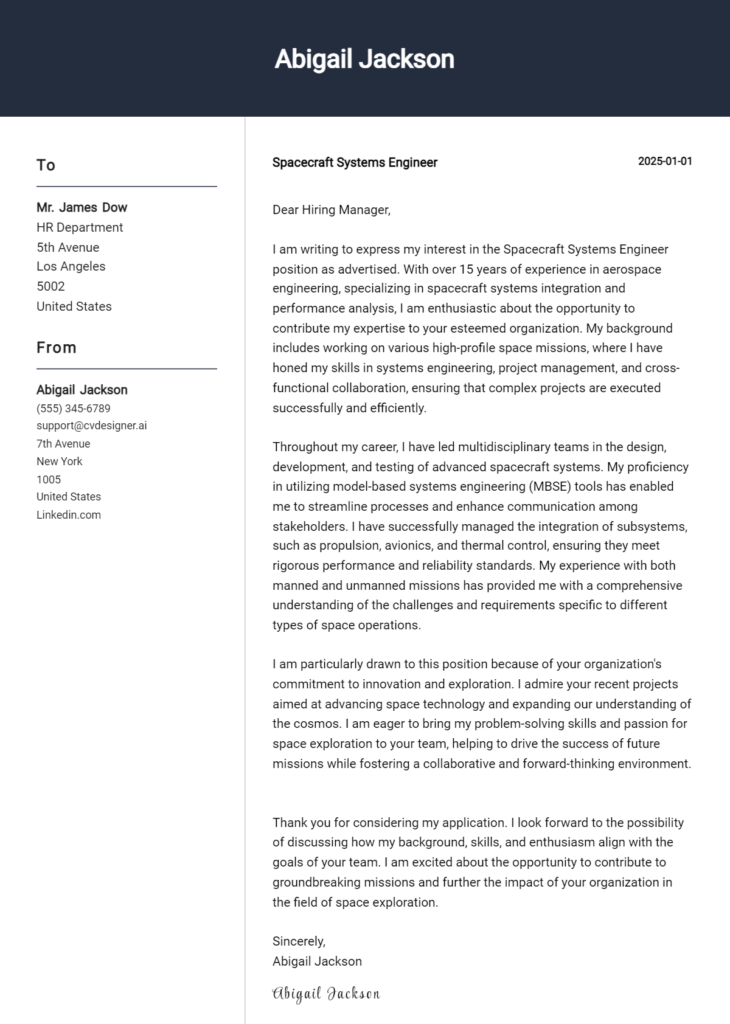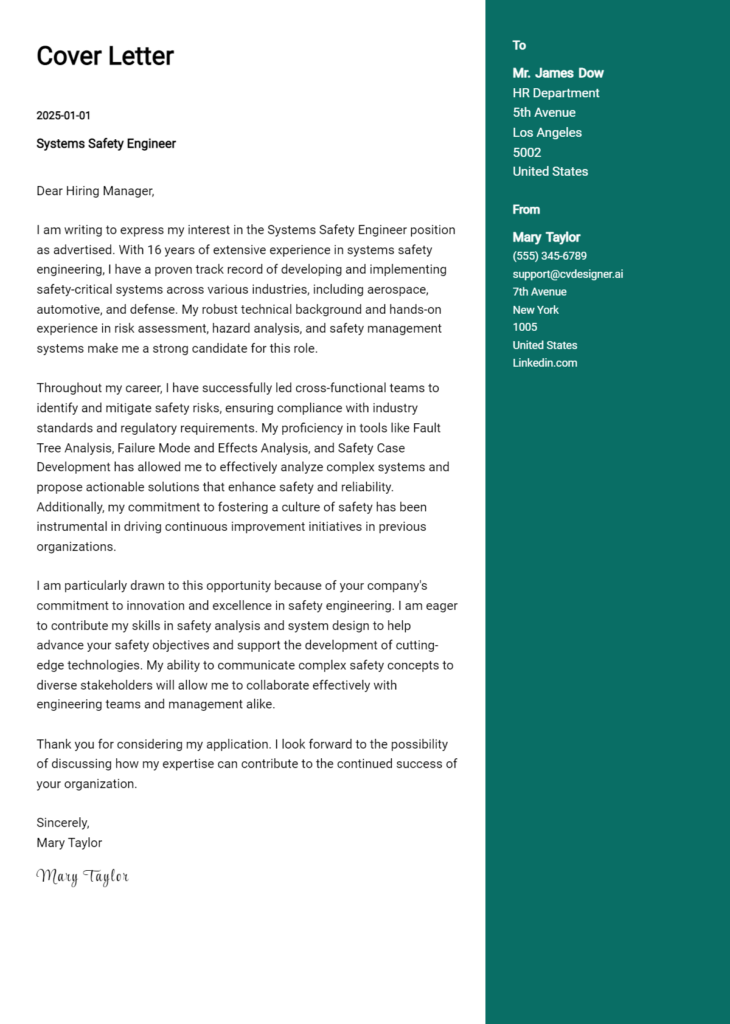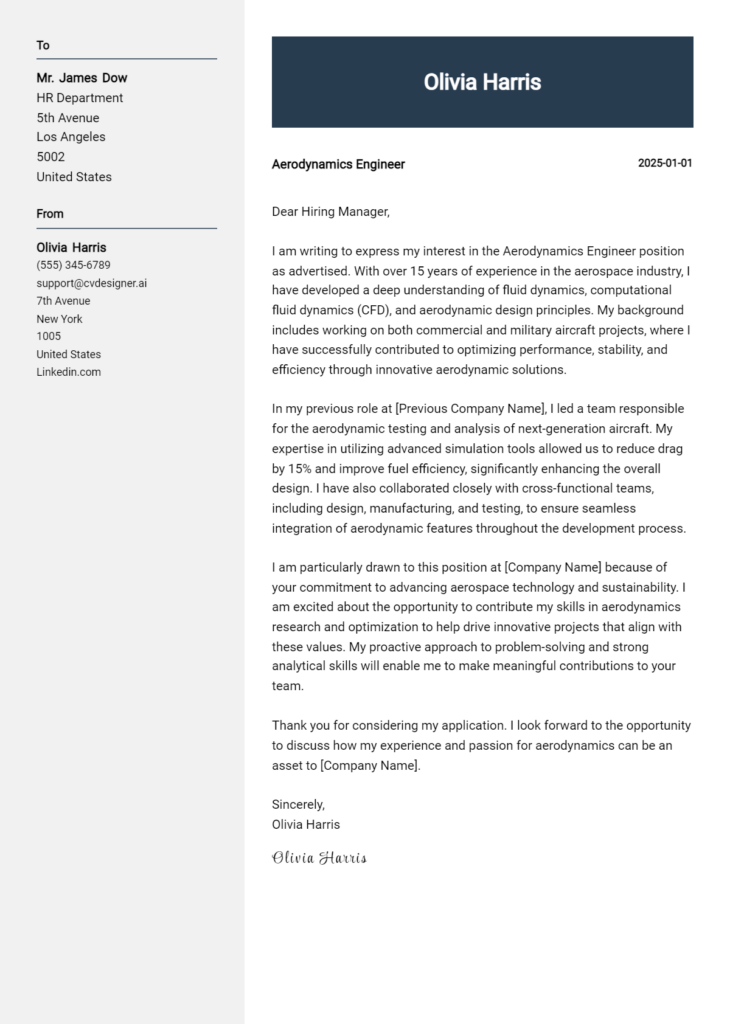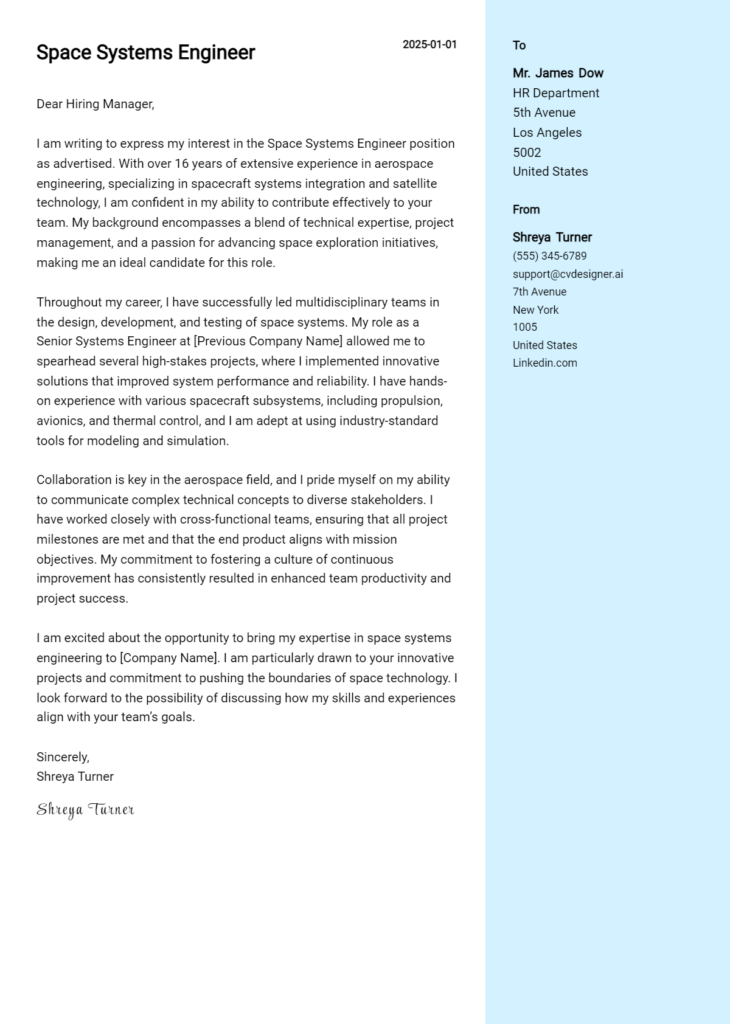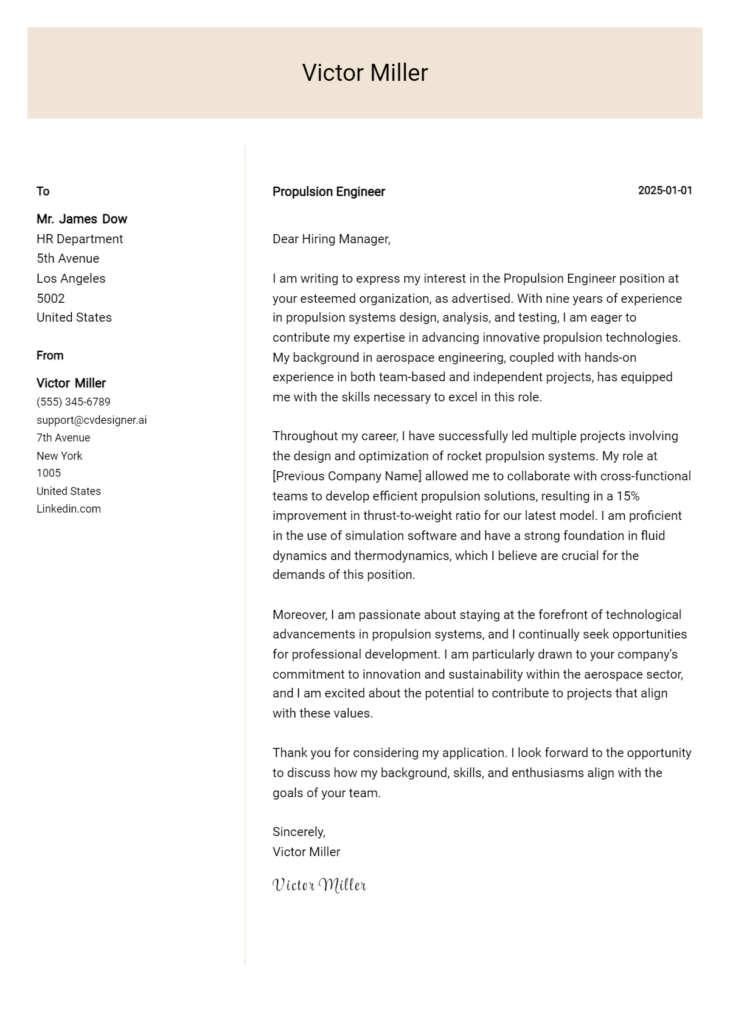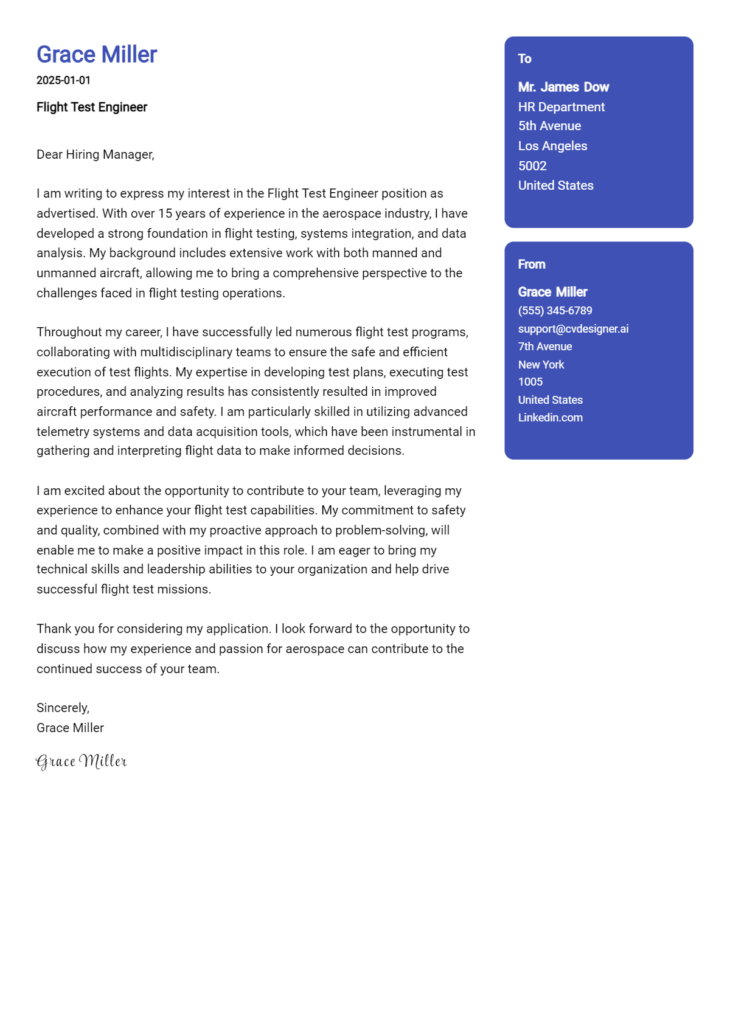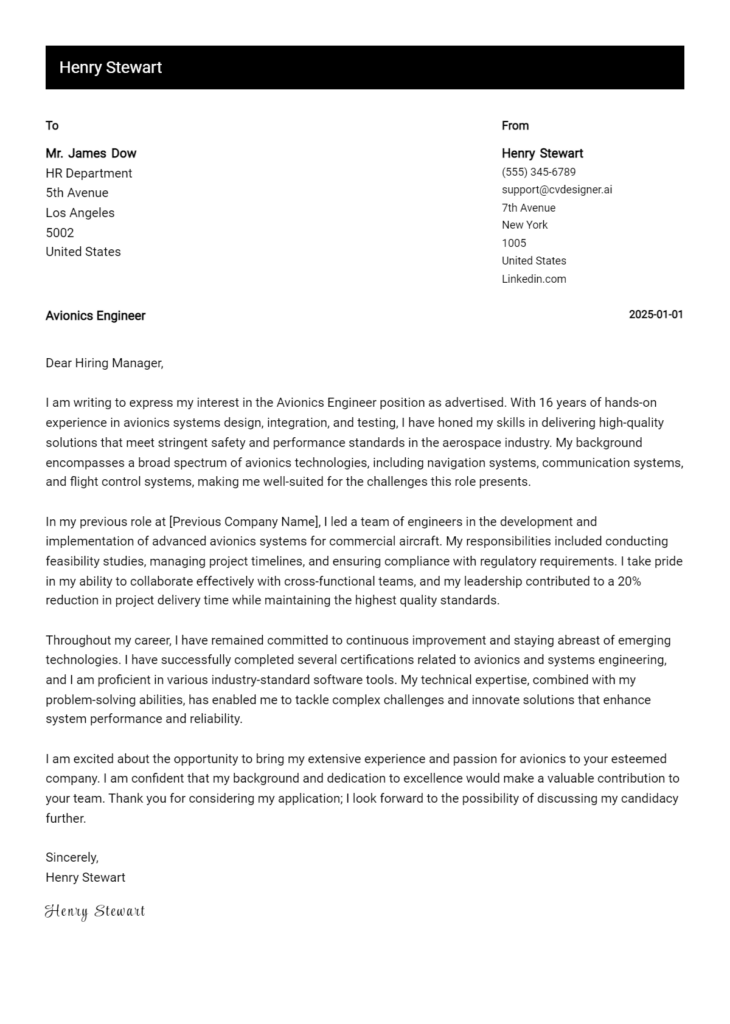Aircraft Design Engineer Cover Letter Examples
Explore additional Aircraft Design Engineer cover letter samples and guides and see what works for your level of experience or role.
The Importance of Cover Letter Formatting for an Aircraft Design Engineer
Crafting a well-formatted cover letter is essential for an Aircraft Design Engineer, as it not only showcases your engineering expertise but also demonstrates your attention to detail and technical proficiency. In a field where precision and clarity are paramount, how you present your skills and experiences can significantly influence the hiring manager's perception of your capabilities. A structured cover letter serves as your first opportunity to communicate your passion for aviation and innovation, while simultaneously reflecting your methodical approach to problem-solving.
In this guide, we will outline the key components of an effective cover letter, providing insights and examples tailored specifically for aircraft design engineers.
We'll focus on the essential components of a professional cover letter, including:
- Cover Letter Header
- Cover Letter Greeting
- Cover Letter Introduction
- Cover Letter Body
- Cover Letter Closing
Each section plays a crucial role in emphasizing your qualifications and professionalism. Let’s dive into each part and explore how to make your cover letter soar above the rest.
Importance of the Cover Letter Header for an Aircraft Design Engineer
The cover letter header is a crucial component of any professional correspondence, particularly for an Aircraft Design Engineer. It sets the tone for the document, showcasing your attention to detail and professionalism right from the outset. A well-structured header should include your contact information, the date, and the recipient's details. This clarity not only makes it easy for the recipient to identify who you are and how to reach you, but it also demonstrates your organizational skills—an essential trait in the engineering field.
Here are examples of a strong and weak cover letter header for an Aircraft Design Engineer:
Strong Example
John Doe 123 Aviation Way Sky City, ST 12345 johndoe@email.com (123) 456-7890 October 1, 2023 Mr. Smith Johnson Hiring Manager Aerospace Innovations Inc. 456 Industry Blvd Tech Town, ST 67890
Weak Example
john doe some street some city email phone number date to whom it may concern
In the strong example, all essential information is clearly presented and formatted correctly, while the weak example lacks professionalism and clarity, making it less effective for a job application.
The Importance of the Cover Letter Greeting
The greeting of your cover letter serves as the first impression you make on a potential employer, setting the tone for the rest of your application. A well-crafted greeting demonstrates professionalism and shows that you have taken the time to personalize your correspondence. Addressing the hiring manager directly not only establishes a connection but also exhibits your motivation and attention to detail. To avoid sounding generic, it's essential to research the recipient's name whenever possible. This effort reflects your genuine interest in the position and the company.
Strong Greeting Example
Dear Dr. Emily Johnson,
Weak Greeting Example
To Whom It May Concern,
By being mindful of your greeting, you can create a positive first impression that encourages the reader to engage with the content of your cover letter.
Importance of a Well-Crafted Cover Letter Introduction for an Aircraft Design Engineer
A compelling cover letter introduction is crucial for any Aircraft Design Engineer applying for a position in the aerospace industry. This initial paragraph serves as the gateway to your application, capturing the hiring manager's attention and setting the tone for the rest of your letter. In a field where precision and innovation are paramount, your introduction should not only convey your enthusiasm for the role but also highlight key skills or achievements that align with the job requirements. A strong introduction can differentiate you from other candidates, while a weak one may leave a lackluster impression, causing your application to be overlooked.
Strong Example
Dear [Hiring Manager's Name], As a passionate Aircraft Design Engineer with over five years of experience in leading innovative design projects, I am excited to apply for the position at [Company Name]. My expertise in advanced aerodynamic modeling and proficiency in CAD software have allowed me to contribute to the successful launch of three major aircraft prototypes. I am particularly drawn to [Company Name]'s commitment to sustainable aviation solutions, and I am eager to bring my skills in lightweight materials and environmental impact analysis to your team.
Weak Example
Dear [Hiring Manager's Name], I am writing to apply for the Aircraft Design Engineer position. I have worked in the industry for a few years and have some skills that might be useful. I am interested in this job because it sounds like a good opportunity.
Purpose of the Cover Letter Body for an Aircraft Design Engineer
The body of a cover letter for an Aircraft Design Engineer serves a critical function in presenting the candidate's qualifications, experiences, and unique contributions to potential employers. It is an opportunity to detail specific projects or accomplishments that highlight technical skills, innovation, and problem-solving abilities relevant to aircraft design. By focusing on measurable outcomes, such as improving design efficiency or contributing to successful project completions, candidates can effectively demonstrate their value and fit for the role.
Strong Example
In my previous role at ABC Aviation, I led a team in the redesign of a critical wing component, which resulted in a 15% reduction in drag and a 10% increase in fuel efficiency. This project not only enhanced the aircraft's performance but also contributed to significant cost savings for our client. My experience with advanced CAD software and collaboration across multidisciplinary teams has equipped me with the skills needed to contribute effectively to your innovative projects at XYZ Aerospace. I am particularly drawn to your commitment to sustainable aviation solutions and would love the opportunity to bring my expertise in lightweight materials and aerodynamics to your team.
Weak Example
I have worked as an Aircraft Design Engineer for several years and have experience with various aircraft designs. I think I would be a good fit for your company because I like airplanes. I have done some projects, but I don’t remember the details. I am eager to learn and help your team with whatever is needed.
Importance of the Cover Letter Closing for an Aircraft Design Engineer
The closing paragraph of a cover letter is a pivotal moment to reinforce your qualifications, express enthusiasm for the position, and prompt the employer to take the next steps in the hiring process. For an Aircraft Design Engineer, it's crucial to succinctly summarize your relevant skills and experiences while showcasing your passion for aerospace innovation. A strong closing not only leaves a lasting impression but also invites the reader to engage further, such as reviewing your resume or scheduling an interview. Below are examples of a strong and weak closing paragraph.
Strong Example
Thank you for considering my application for the Aircraft Design Engineer position. With my extensive experience in aerodynamics and proficiency in CAD software, I am excited about the opportunity to contribute to your innovative team at [Company Name]. I am looking forward to discussing how my background and skills align with your needs. I hope to schedule a time for an interview to explore this exciting opportunity further. Please find my resume attached for your review.
Weak Example
I guess that's it. I'm interested in the Aircraft Design Engineer job. My resume is attached, so you can look at it if you want. I hope to hear back from you soon.
Crafting an effective cover letter is essential for candidates aspiring to become Aircraft Design Engineers. This document serves as a platform to showcase your unique skills and experiences that align with the demands of this specialized role. It’s crucial to highlight your technical abilities, problem-solving skills, knowledge of the software development life cycle (SDLC), teamwork experience, and a commitment to continuous learning. Here are some valuable tips to help you create a compelling cover letter that stands out.
Tips for Writing an Effective Cover Letter
Highlight Technical Skills
Your cover letter should clearly articulate your technical expertise relevant to aircraft design. Mention specific software tools and technologies you are proficient in, such as CAD programs, MATLAB, or computational fluid dynamics (CFD) software. Providing examples of projects where you applied these skills can make your application more persuasive.Demonstrate Problem-Solving Abilities
Aircraft design often involves complex challenges. Illustrate your problem-solving skills by recounting a specific situation where you identified a significant issue and successfully developed a solution. Use the STAR (Situation, Task, Action, Result) method to structure your response and provide measurable outcomes.Showcase Knowledge of SDLC
As aircraft design often involves extensive development processes, it’s beneficial to demonstrate your understanding of the Software Development Life Cycle. Discuss your experience with each phase, from requirements analysis to design, implementation, testing, and maintenance. This shows potential employers that you can contribute to the entire process effectively.Emphasize Teamwork and Collaboration
Collaboration is key in aircraft design projects, which often involve multidisciplinary teams. Share examples of past experiences where you worked successfully in a team setting. Highlight your ability to communicate ideas clearly and your willingness to listen to and incorporate feedback from others.Express Passion for Continuous Learning
The aerospace industry is constantly evolving, so it’s vital to convey your enthusiasm for ongoing education and professional development. Mention any relevant certifications, workshops, or courses you’ve completed. Additionally, express your eagerness to keep up with emerging technologies and industry trends, demonstrating that you are proactive about enhancing your skills.
By following these tips, you can create a strong cover letter that not only highlights your qualifications but also reflects your dedication to the field of aircraft design. For additional assistance, consider using cover letter templates or a cover letter builder to help streamline the process and ensure your letter is polished and professional.
Common Mistakes to Avoid in an Aircraft Design Engineer Cover Letter
Crafting a compelling cover letter is vital for standing out in the competitive field of aircraft design engineering. Avoiding common mistakes can significantly enhance your chances of securing an interview. Here are some frequent pitfalls and tips on how to steer clear of them:
Generic Content: Using a one-size-fits-all approach can make your application seem unprofessional. Tailor your cover letter to the specific job and company by highlighting relevant skills and experiences.
Lack of Specificity: Failing to provide specific examples of your achievements can weaken your case. Quantify your accomplishments where possible, such as stating how you contributed to a project that improved efficiency by a certain percentage.
Ignoring Format Guidelines: A poorly formatted cover letter can distract from your qualifications. Adhere to the recommended cover letter format to ensure your letter is clear and professional.
Spelling and Grammar Errors: Typos and grammatical mistakes can undermine your credibility. Always proofread your letter or consider using tools like grammar checkers before submission.
Overly Technical Language: While industry-specific terminology is important, overusing jargon can alienate the reader. Strive for a balance that demonstrates expertise without becoming incomprehensible.
Neglecting the Closing: An effective closing is essential for leaving a strong impression. Reiterate your enthusiasm for the role and encourage the hiring manager to contact you for further discussion.
Not Including a Call to Action: Failing to invite the reader to take the next step can make your letter seem passive. Express your desire to discuss your qualifications in more detail.
By steering clear of these common mistakes and utilizing resources like cover letter examples, you can craft a persuasive cover letter that showcases your qualifications as an aircraft design engineer.
Cover Letter FAQs for Aircraft Design Engineer
What should I include in my cover letter as an Aircraft Design Engineer?
In your cover letter, highlight your relevant technical skills, such as proficiency in CAD software, knowledge of aerodynamics, and familiarity with materials used in aircraft design. Include specific examples of past projects that showcase your problem-solving abilities and innovative designs. Mention any relevant certifications or degrees, such as a bachelor's in aerospace engineering. It's also beneficial to express your passion for aviation and how your values align with the company's mission. Finally, end with a strong closing statement that reiterates your enthusiasm for the position and invites further discussion.
How do I tailor my cover letter for a specific job application?
To tailor your cover letter, start by thoroughly reading the job description and identifying key skills and qualifications the employer is seeking. Use specific language from the job listing to demonstrate that you understand their needs. Highlight experiences or projects that directly relate to these requirements, ensuring you connect your skills to the company's goals. Additionally, research the company culture and values; incorporate this knowledge to show how you would be a good fit. Personalizing your cover letter will make it stand out and demonstrate your genuine interest in the role.
Should I include technical jargon in my cover letter?
While it's important to demonstrate your technical knowledge, be cautious about overusing jargon. Your cover letter should be accessible to readers who may not have a technical background, such as HR personnel. Use clear and concise language while incorporating relevant terms that showcase your expertise. Aim for a balance that allows you to convey your qualifications without alienating non-technical readers. If possible, explain any complex concepts briefly to ensure clarity while still emphasizing your technical capabilities.
How long should my cover letter be for an Aircraft Design Engineer position?
Your cover letter should ideally be one page long, consisting of three to four paragraphs. Start with a strong introduction that captures the employer's attention, followed by a brief overview of your qualifications and relevant experience. Use the main body to elaborate on your achievements, focusing on specific projects or skills that relate to the job. Conclude with a call to action, expressing your enthusiasm for the opportunity and inviting further discussion. Keeping your cover letter concise and focused will make it easier for hiring managers to read and digest your key points.
Build your Cover Letter in minutes
Use an AI-powered cover letter builder and have your letter done in 5 minutes. Just select your template and our software will guide you through the process.

